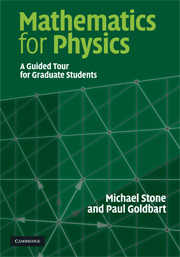Book contents
- Frontmatter
- Contents
- Preface
- Acknowledgments
- 1 Calculus of variations
- 2 Function spaces
- 3 Linear ordinary differential equations
- 4 Linear differential operators
- 5 Green functions
- 6 Partial differential equations
- 7 The mathematics of real waves
- 8 Special functions
- 9 Integral equations
- 10 Vectors and tensors
- 11 Differential calculus on manifolds
- 12 Integration on manifolds
- 13 An introduction to differential topology
- 14 Groups and group representations
- 15 Lie groups
- 16 The geometry of fibre bundles
- 17 Complex analysis
- 18 Applications of complex variables
- 19 Special functions and complex variables
- A Linear algebra review
- B Fourier series and integrals
- References
- Index
13 - An introduction to differential topology
Published online by Cambridge University Press: 05 June 2012
- Frontmatter
- Contents
- Preface
- Acknowledgments
- 1 Calculus of variations
- 2 Function spaces
- 3 Linear ordinary differential equations
- 4 Linear differential operators
- 5 Green functions
- 6 Partial differential equations
- 7 The mathematics of real waves
- 8 Special functions
- 9 Integral equations
- 10 Vectors and tensors
- 11 Differential calculus on manifolds
- 12 Integration on manifolds
- 13 An introduction to differential topology
- 14 Groups and group representations
- 15 Lie groups
- 16 The geometry of fibre bundles
- 17 Complex analysis
- 18 Applications of complex variables
- 19 Special functions and complex variables
- A Linear algebra review
- B Fourier series and integrals
- References
- Index
Summary
Topology is the study of the consequences of continuity. We all know that a continuous real function defined on a connected interval and positive at one point and negative at another must take the value zero at some point between. This fact seems obvious – although a course of real analysis will convince you of the need for a proof. A less obvious fact, but one that follows from the previous one, is that a continuous function defined on the unit circle must posses two diametrically opposite points at which it takes the same value. To see that this is so, consider f (θ + π) – f (θ). This difference (if not initially zero, in which case there is nothing further to prove) changes sign as θ is advanced through π, because the two terms exchange roles. It was therefore zero somewhere. This observation has practical application in daily life: our local coffee shop contains four-legged tables that wobble because the floor is not level. They are round tables, however, and because they possess no misguided levelling screws all four legs have the same length. We are therefore guaranteed that by rotating the table about its centre through an angle of less than π/2 we will find a stable location. A ninety-degree rotation interchanges the pair of legs that are both on the ground with the pair that are rocking, and at the change-over point all four legs must be simultaneously on the ground.
Similar effects with a practical significance for physics appear when we try to extend our vector and tensor calculus from a local region to an entire manifold.
- Type
- Chapter
- Information
- Mathematics for PhysicsA Guided Tour for Graduate Students, pp. 449 - 497Publisher: Cambridge University PressPrint publication year: 2009



